Company: Nike
CEO: John Joseph Donahoe
Founders: Phil Knight and Bill Bowerman
Year founded: 1964
Headquarter: Beaverton, Oregon
Employees (FY23): 83,700
Type: Public
Ticker Symbol: NKE
Revenue (FY23): US$51.21 Billion
Profit | Net income (FY23): US$5.07 Billion
Products & Services: Apparel | Athleisure | Footwear | Sports Equipments | Accessories
Competitors: Adidas | Under Armour | Allbirds | New Balance | Sketchers | Puma | Fila | ASICS | Lululemon | Fabletics | Victoria Secrets | Vans
Did you know?
Nike swoosh logo is inspired by the Greek goddess of victory, Nike

An Overview of Nike
Nike, Inc. is an American multinational corporation. Nike is headquartered in Beaverton, Oregon, USA. It was found by Bill Bowerman and Phil Knight in the year 1964. The company specializes in athletic wear, providing footwear, apparel, athletic equipment, and accessories.
Nike’s primary goal is to supply athletes with exceptional products and wearable that aids them in better sports performance. However, due to the success, Nike has gotten the company now provides athleisure wear as well. Currently, John Donahoe is the CEO of Nike.
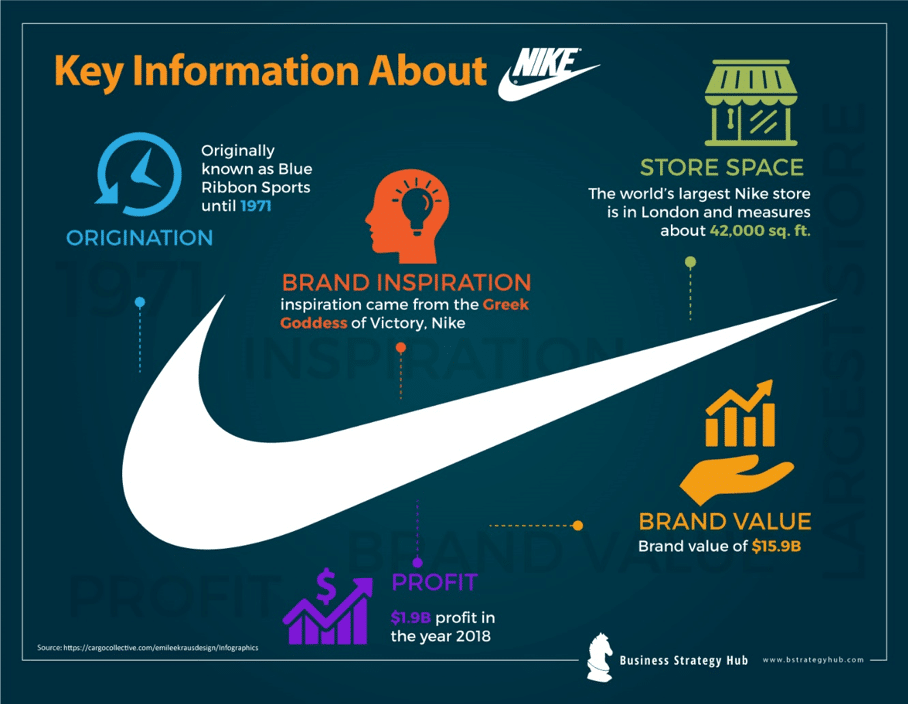
SWOT Analysis of Nike
Here’s a detailed breakdown of Nike SWOT analysis.
Nike’s Strengths – Internal Strategic Factors
1. Strong Brand Awareness and Brand Value
Nike is one of the most recognizable brands in the world as its name alone is memorable, easy to pronounce, and very unique. Its swoosh symbol is easily recognized by everyone. According to Interbrand global brand ranking report, Nike is ranked at # 9 position with a brand value of $53.7 Billion.
2. Huge Customer base
Nike has millions of customer from around the world who loyally follow Nike’s trends, participate in Nike events, and even provide customer feedback. Due to its huge popularity, Nike’s market cap has grown to $142.2 billion as of March 2024.
3. America’s Favorite Sneaker Brand
Nike is the most popular and favorite sneaker brand in the U.S., according to a consumer insights survey by Statista.
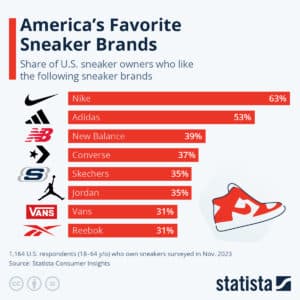
4. Aimed For Sustainability
Nike’s CEO Mark Parker has addressed that they will continue to acknowledge the environmental issues in the communities. The CEO ensures that Nike will help to contribute in finding a solution against these environmental issues.
5. Iconic Relationships
Nike’s long-term partnership with Michael Jordan has proved to be beneficial in terms of sales for the company. Their collaboration resulted in “Air Jordan 1 Shoes”. Additionally, Nike teamed up with the famous basketball player to help design the “Air Jordan 1 Shoes”.
6. Side Brands
Nike’s ability to maintain and enhance its side brands such as converse and Hurley have enabled it to enjoy unparalleled success for decades.
7. Low Manufacturing Cost
Most of Nike’s footwear is manufactured in foreign countries. In the fiscal year 2023, Vietnam produced 50%, Indonesia produced 27%, and China produced 18% of total Nike’s footwear. Other operations are in Argentina, Brazil, India, Italy, and Mexico.
8. In-house Professionals
Nike has a professional team that designs its shoes and other athletic accessories. Nike believes their business has flourished due to their thorough research, design, and development efforts.
9. Superior Marketing Capabilities
Nike has excellent marketing campaigns. The brand heavily relies on demand creation expense, which includes advertisement, promotion, endorsement contracts, media print and complimentary products. In the fiscal year 2021, 2022 and 2023, Nike spent $3.1 billion, $3.8 billion, and 4.06 billion respectively. The brand has successfully utilized social media and marketing campaigns to target more customers.
10. Black Community Support
The brand has excellent marketing campaigns and released “Don’t Do It” ad campaign in support of Black communities against racism.
11. High Market Share
Nike is a market leader in footwear industry. Nike has captured approximately 39% of the global athletic footwear market and 13% of global athletic apparel market.
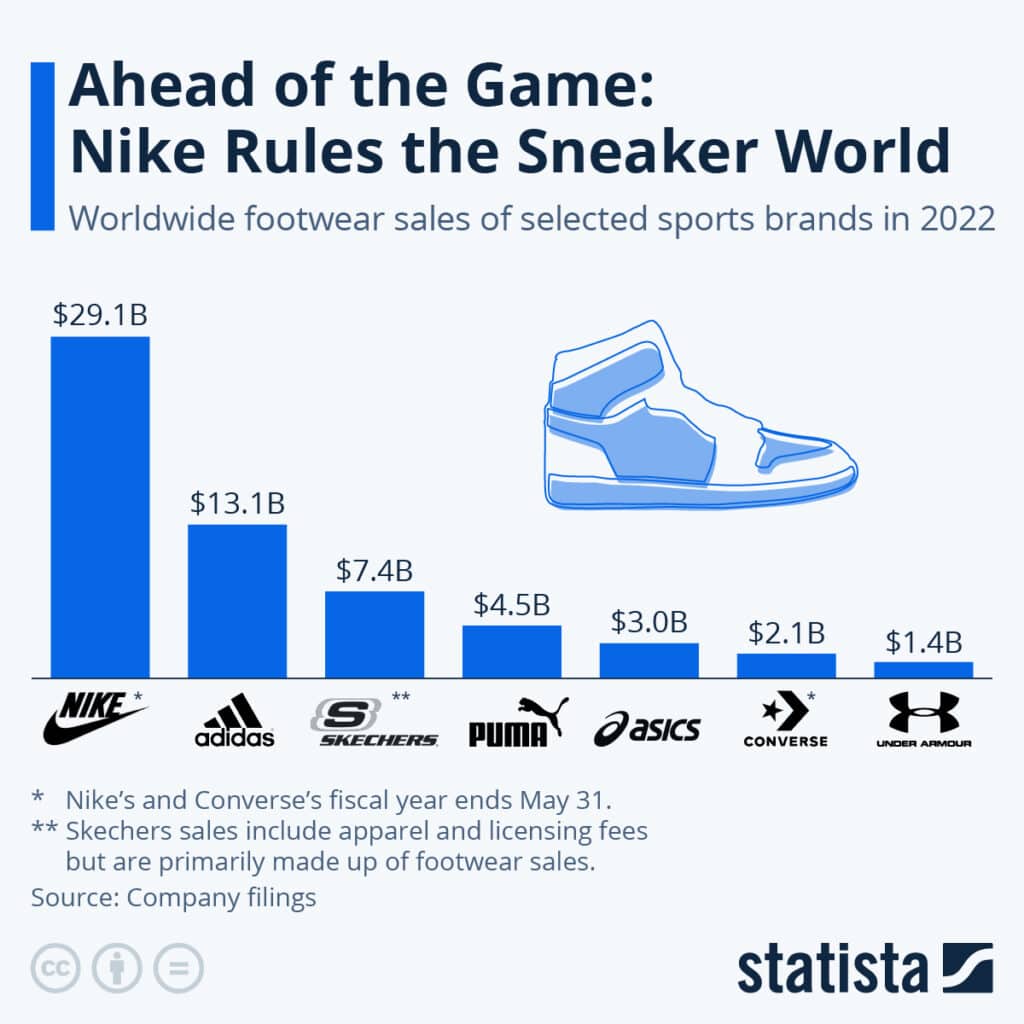
Nike’s Weaknesses – Internal Strategic Factors
1. Poor Labor Conditions in Foreign Countries
In the last 20 years, Nike has been consistently targeted regarding their poor labor conditions. These issues include forced labor, child labor, low wages, and horrific working conditions that were deemed “unsafe”.
2. Retailers Have a Stronger Hold
Nike’s retail sector makes Nike weak due to its sensitivity against pricing. 56% of Nike products are sold directly to wholesalers or retailers. With retailers serving as their core customers, Nike does not put up a fight against their pricing structures whatsoever.

3. Pending Debts
Although Nike’s income statements prove to be prosperous, a quick glance at their balance sheet could paint a different picture. Nike is still facing financial threats. As of FY23, Nike’s total long term debt was $8.9 billion
4. Lawsuits
- Recently, a former employee accused Nike of discrimination based on his Croatian origin.
- Four former female Nike employees filed a class-action lawsuit against the company in August 2018. According to these women, Nike has a toxic company culture for women. The women filed their case against the sportswear company claiming that the company violated the Equal Pay Act. The women said the company engaged in systematic gender pay bias where men were paid more than women for the same amount of work.
5. Lack of Diversification
Nike’s over-dependence on sporting footwear and apparel or lack of diversification is a major weakness. During the pandemic, major sporting events were canceled or postponed. If there is a similar crisis in the future, Nike’s losses can be catastrophic.

6. Contradicting Strategies
Nike pledged to shift all its facilities to 100% renewable energy with net-zero carbon emissions under the “Move to Zero” scheme. While the strategy is great and welcomed, it contradicts Nike’s strategy that favors innovation over sustainability. This creates the perception that Nike is not committed to addressing climate change and its pledge is just a marketing stunt.
7. Dependency on North America especially US Market
Even after having established itself globally, Nike still relies on the U.S Market in terms of sales and revenue. In the fiscal year 2023, about 44% of Nike’s sales came from the North America, while the rest of 56% came globally. Despite its fame, Nike depends on the U.S for substantial sales and growth.

8. Sexual Harassment
Former female employees also pointed out that sexual harassment and misconduct was very common in the company. The New York Times conducted interviews with 50 former and present Nike employees to investigate the company culture. Through the interviews, it was established that Nike did have a toxic working environment, where sexual misconduct was rampant.
Multiple female employees reported that they had complained to the HR but saw no action being taken from their part. The women were left devastated and felt unsafe while working at Nike. Some even left their jobs. The entire controversy has significantly affected the company’s image.
9. End of Iconic Tiger Woods & Nike Partnership
Tiger Woods’ 27-year Nike partnership has come to an end. In a world where brands compete to bring the most sought-after celebrity for their brand endorsements, Nike has lost a golf legend.
Woods was the face of Nike Golf brand, and Nike Golf’s revenue ranged from approximately $600 – 800M from fiscal 2006-2017. Experts believe Nike has more to lose in the long term after cutting ties with Woods.

Nike’s Opportunities – External Strategic Factors
1. Emerging Markets
Although Nike already has a presence in many foreign countries, there is still plenty of opportunities for Nike. This is because emerging markets like India, China, and Brazil are gradually flourishing.
2. Innovative Products
Although Nike has produced many products, there is still a lot to innovate. Nike has extended its reach in technology in association with fitness and health. Products like wearable technology that monitors physical activities, is the first step in building innovative technology products. Combining technology with athletic wear can prove to be beneficial as it is an aspect of the fashion industry that still hasn’t been explored much.
3. Efficient Integration
The supply and production of Nike’s products depend on independent manufacturers. The brand can either acquire a few of these or make some of its own for a more efficient and streamlined supply chain.
4. Cutting ties with big retailers
Nike has decided to cut ties with some of the biggest multi-brand retailers and wholesale partners. According to the report, Nike will no longer work with wholesale retailers such as Zapoo’s, Dillard’s, Fred Meyer, Bob’s Stores, etc. The step is taken for better product positioning and greater customer experience.
5. Acquired Artificial Intelligence Start-up
With its vast financial resources, Nike can acquire small or medium companies or startups. It recently acquired predictive analytics platform – Celect to expand its online sales capabilities and predict customer’s shopping behavior.
6. Merges with the Metaverse
Recently, Nike acquired RTFKT, a digital shoe-making company. Yes, you heard that right, the company designs shoes, but for the virtual stratosphere only. However, RTFKT also claimed that it partnered with FEWOCiOUS (a young artist) to sell real shoes along with their digital versions. Nike is banking on the opportunity to market their digital shoes on the Metaverse, where players can use their Metamask wallets to purchase different types of in-game merchandize.
7. Exiting From Wholesale Distribution
Recently, Nike announced it’s going to be exiting the wholesale distribution market in the U.S. The company plans to only market its products at Nike stores, app, and websites. According to Nike, the move away from distributors is going to help them double their profit margins. Moreover, Nike will also have the opportunity to spearhead the customer shopping experience as well as control prices.
8. Nike to End Use Of Kangaroo Leather For Its Shoes
Nike has announced a significant move that will please both animal rights activists and consumers. The athletic apparel giant will no longer use kangaroo skins in their shoes, ending a controversial practice. The decision comes after Puma made a similar move weeks ago.
Instead of kangaroo leather, Nike will use synthetic material in its new line of Tiempo football boots, the Tiempo Legend Elite, set to launch this summer. The company also ended its partnership with its sole kangaroo leather supplier in 2021, reflecting its commitment to more sustainable and ethical practices.
9. Consumer Direct Strategy
Nike has accelerated the consumer-direct strategy, which means shifting its focus to digital business and subsequently closing physical stores. In fiscal year 2023, 44% of its Nike revenue comes from online sales. Clearly, the pandemic is shaping up how Nike interacts with its customers.

Nike’s Threats – External Strategic Factors
1. Counterfeit Products
Counterfeit products can significantly affect the revenue and reputation of Nike. The company deals globally and the risk of counterfeit products has become higher. A number of merchandisers and retailers offer counterfeit Nike products at lower prices.
The low-priced products are made from low-quality materials but still have the Nike label. This can tarnish the image of the brand as the customers might feel that Nike has started producing low quality products.
2. Increased Competition
Although, Nike is a dominating the athletic industry, competition, and new emerging brands (On, Hoka etc.) are still potential threats to the company. Due to high competition, Nike has to spend more money on marketing and advertising to differentiate itself.
Nike spent $4.06 Billion specifically on marketing and demand generation in fiscal year 2023. To overpower competition, Nike’s safest bet is to design innovative products that are tailored according to the needs of athletes.
3. Marketing Budget Pressure
Companies like Under Armour , Adidas and Lululemon are spending more on marketing and advertising campaigns, increasing the pressure on Nike.
4. Currency Foreign Exchange Risks
Since the brand operates globally, it is affected by fluctuating foreign exchange rates. Nike reports its financial earnings in U.S dollars. This affects its revenue as the U.S dollar is exposed to volatility against other financial currencies.
5. Patent Disputes
Regardless of whether a company is wrong or right, patent disputes are hotly and fiercely contested in the public domain and expose some dirty secrets about sides in the dispute. Nike and Adidas have been engaged in a fierce patent disputes over Primeknit and Flyknit shoes in U.S. and German courts.
6. Economic Uncertainty
Regardless of the industry, all companies are susceptible to the negative effects of a global recession. During lockdown, Nike had reported a decline in sales and sales can drop further in the future if the recession strikes as hard as predicted by experts.
7. Trade Tensions
Nike depends on different markets across the world evidenced by the recent increase in its stocks rallied by an increase in sales in China. With China and the US as its biggest markets, a large chunk of Nike’s sales will be threatened if the trade tensions between the two giants escalate.
8. Patent Conflict towards Adidas Primeknit Shoes
In an appeal to a U.S. agency, Nike filed a complaint that Adidas has been infringing on the company’s Flyknit shoe technology patent. The company also stated that the German shoe manufacturer had used Nike’s Flyknit tech in 49 shoe designs (which uses Primeknit tech).
However, according to an Adidas representative, the company will fight these claims and stated that Adidas has started using their Primeknit technology after numerous years of research and development.
9. Risk to Kangaroo Population
Nike has been accused of putting the Australian kangaroo population at risk of extinction. The leading athletic brand uses kangaroo skin to manufacture leather football shoes. Animal rights activists and advocates have urged Nike to rethink its strategies and to use plant-based alternatives. So far, Nike hasn’t responded to these allegations.
10. Nike Faces A Wave Of Retail And Warehouse Thefts
Nike experiences a surge in theft crimes throughout its supply chain, including warehouse and train thefts. According to the National Retail Foundation, retail theft has become a massive problem in the United States, with an estimated cost of $95 billion.
The company has reported that thieves are stealing from shelves and vehicles. This forced Nike to close a popular outlet store in its hometown of Portland. In addition, two suspects were arrested in Memphis for stealing Nike merchandise worth about $60,000 from five rail cars. Despite having 369 stores across the United States, including outlets and Converse stores, Nike finds it hard to prevent theft along its entire supply chain.
11. Nike Sues Lululemon Over Patent Infringement
Nike has filed a complaint in Manhattan federal court against Canadian athletic apparel company, Lululemon, alleging patent infringement of at least four footwear products.
Nike claims that Lululemon’s Blissfeel, Chargefeel Mid, Chargefeel Low, and Strongfeel footwear have caused economic harm and irreparable injury to the company.
Although this isn’t the first time Nike sued Lululemon for patent infringement, the recent complaint alleges that three patents have been infringed, including one addressing the performance of footwear when force is applied. While the company seeks unspecified damages, Lululemon has yet to comment on the matter.
12. Decline in Demand for Classic Shoe Brands
Nike faces tough competition with running shoe competitors like On, Hoka, and New Balance. The analyst believes that the company’s heavy reliance on classic shoes like Air Jordan and Pegasus led to complacency, and it needs to catch up on innovation. There is declining interest in wearing Air Jordan sneakers, and they are not as cool anymore.
Nike plans to scale back classics and introduce new products to attract customers from rival brands.
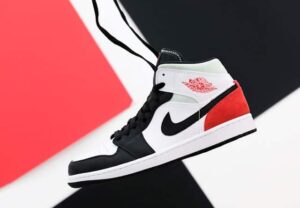

Final Thoughts
The fiscal year 2023 proved to be successful for Nike. Although the brand is still in debt, the next few years look promising. Nike has grown exponentially in the last decade.
From releasing new product lines to building new brands, to outsourcing, and establishing a global presence alone is an extraordinary achievement.
Through this SWOT analysis of Nike, you will be able to understand the business model of the brand.
References & more information
-
Xu, V. Your favorite Nikes might be made from forced labor. Here’s why. The Washington Post.
- Cara Salpini. Nike is on track to make $50 billion this year. How much is that, really? Retail Dive
- Interbrand – Best Global Brands

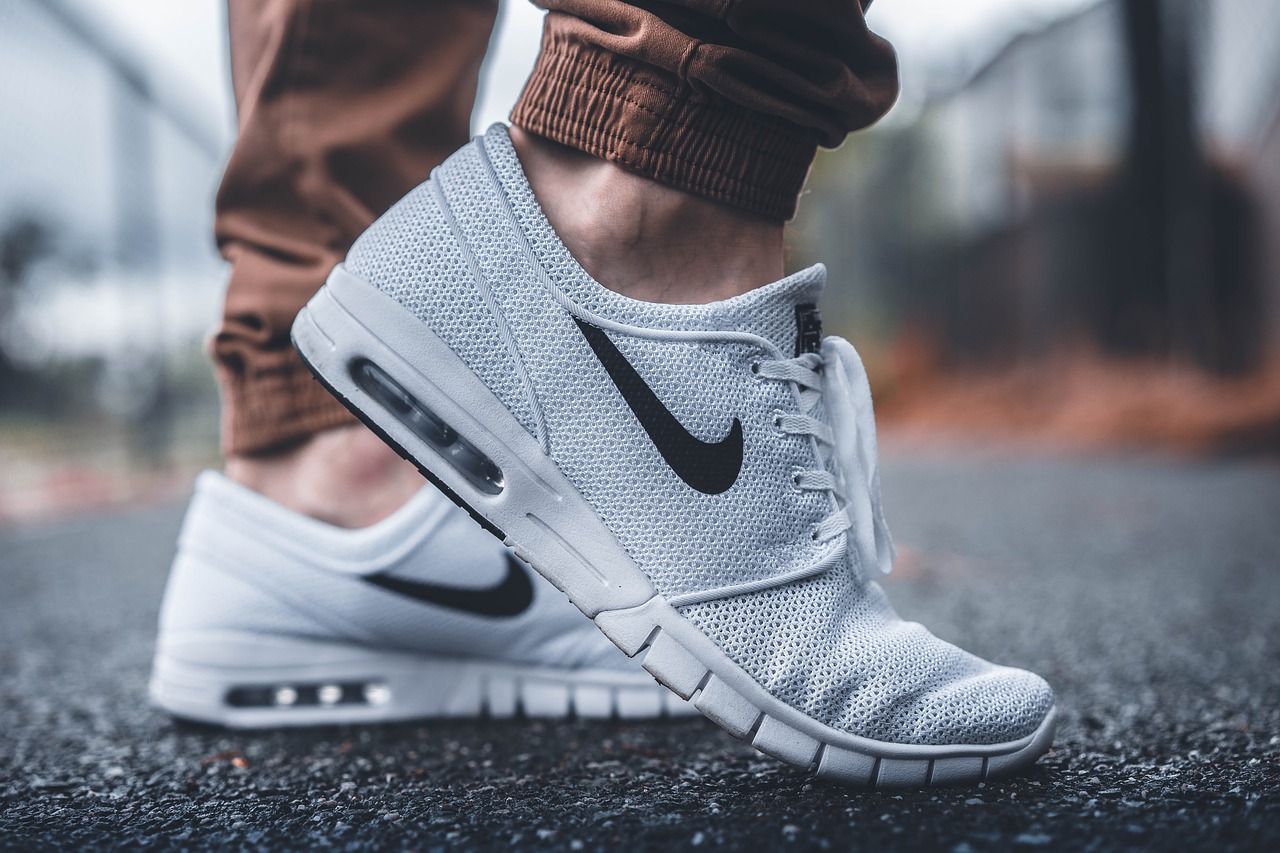



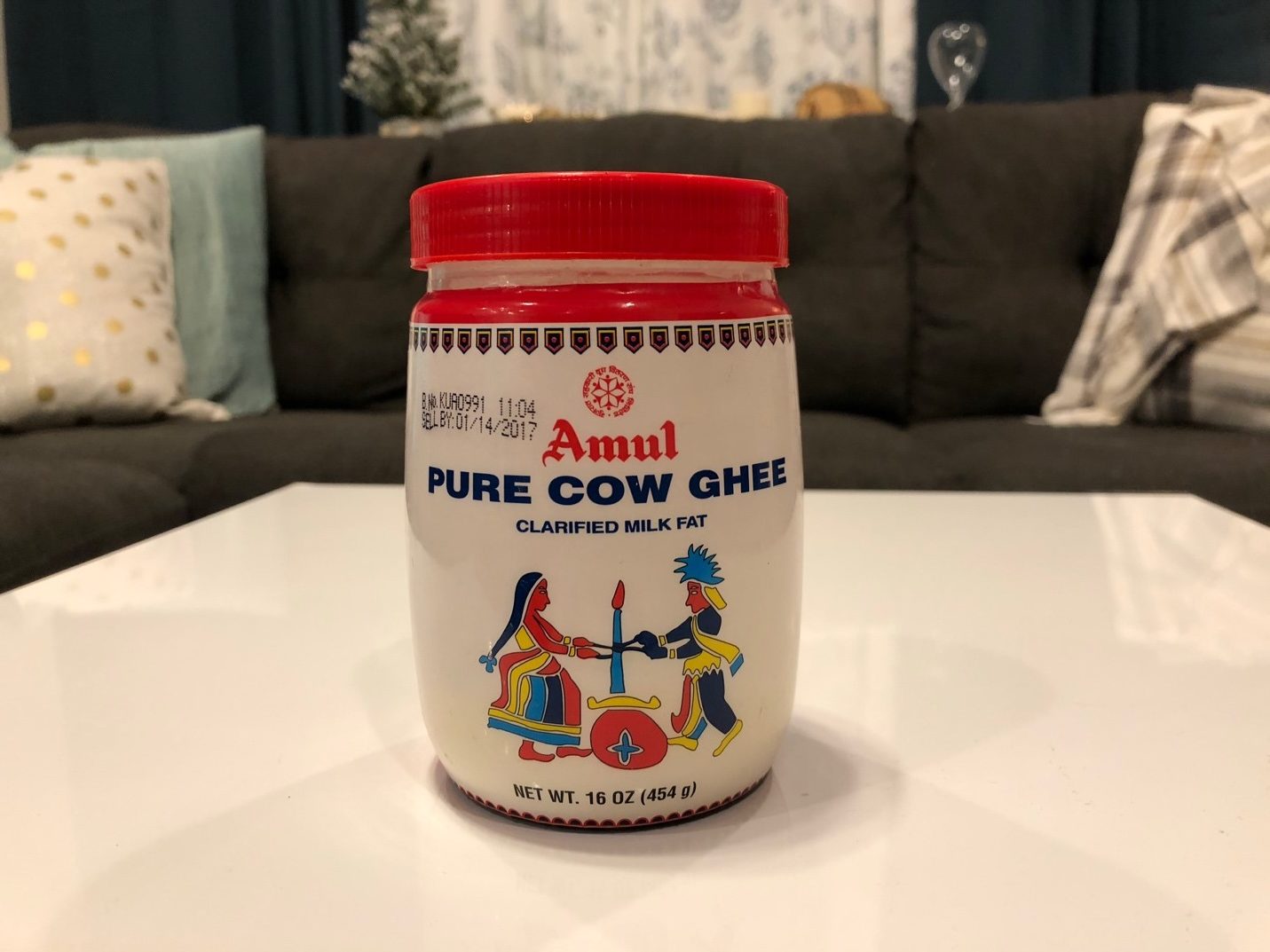
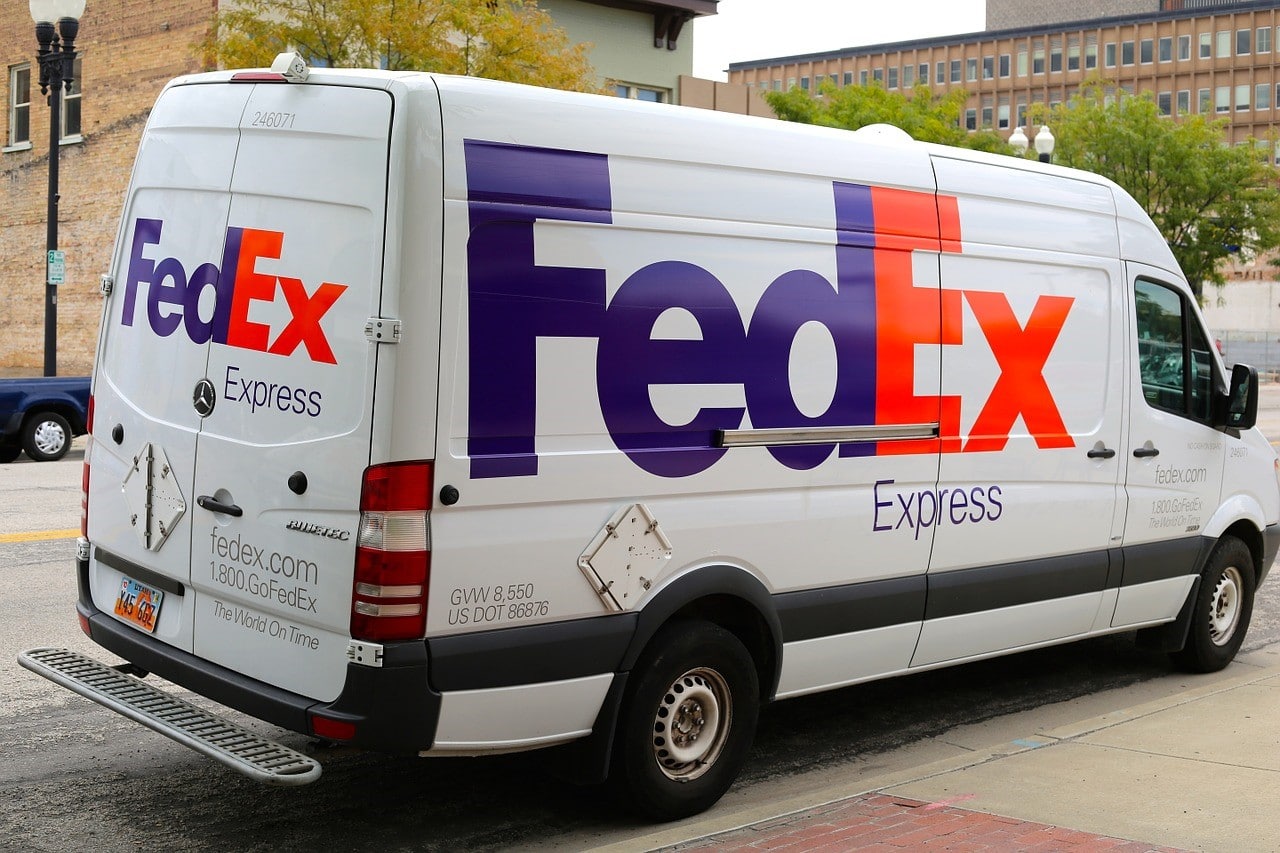

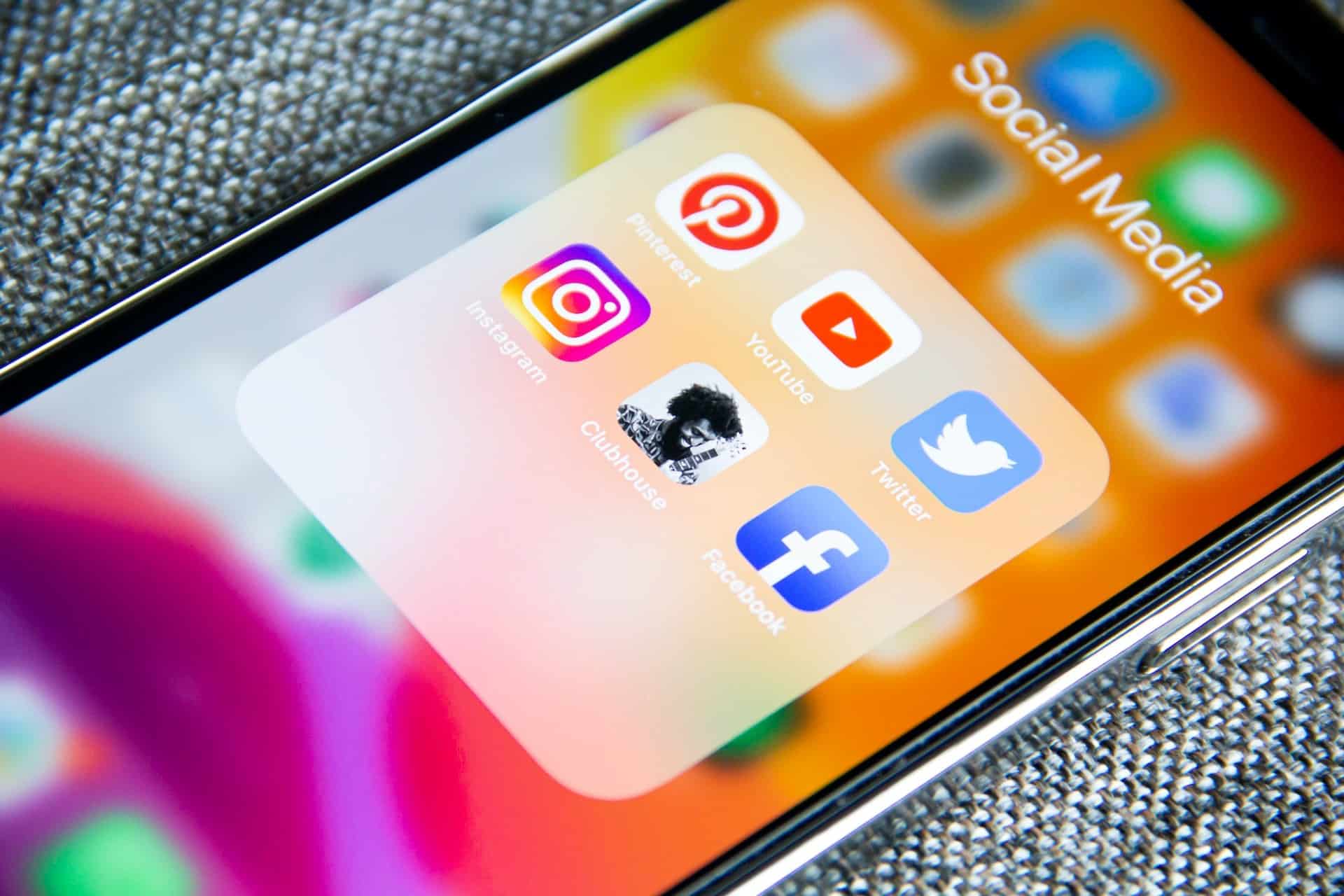



This article was very interesting. Thank you. The article was enlightening.
Dorrene,
Thanks for your positive feedback, I am glad you liked it.
It’s to easy to understand and explain to others..
Thanks it will help me my upcoming presentation. 😃
Thank you Gargi,
I have been through business school not so long ago, so I can totally relate to you. I am guessing the presentation is for school?
No. I m persuing MBA integrated..
Great, All the best for your MBA!
Lot of clarity in the format – the SWOT is explained.
Using for my management program – Leadership & People Management. It’s a great help. Thanks.
Hi Choo Patrick,
I am glad you liked our analysis. Thank you !
i want to know the publisher of this analysis
Hi Ap, here are the details
Date of Publish : Dec 17, 2018
Author : SG
Quick and to the point. Good read. Thank You
Oasis,
I am glad you liked it !
who wrote this article ? can i know the name? very grateful analysis.
Thanks Taku, I am glad you liked our analysis.
– SG
why is there no reference?
Hi Divya,
Most of the information is from Nike’s annual report and few points have embedded hyperlinks for references.
top analysis
THIS HELPED ME A LOT!
Hey, who is the author of this report and what year was it finalized. I need this info for citations.
Hey Justin,
Author: S.K Gupta
First published: December 17, 2018
Last updated: Oct 06, 2020
Hey! loved it, read it in my class!
Hi Aden,
Glad you loved it, happy reading !
Hey this was super helpful for a school project. Thank you.
Thanks Nicholas for the feedback, glad to see it was helpful.
Happy Reading 🙂
I really love your work thank you this was so helpful to help me help another person but not me thank you for this thank you.
Dear Mr. Gupta ,
Thanks for publishing this excel report about Nike, do you have the latest BCG matrix about Nike’s product. If yes, can you share to me me on my below email
Hi Ahmed, Glad you liked Nike swot analysis,
Unfortunately, we don’t have the latest BCG matrix on Nike.